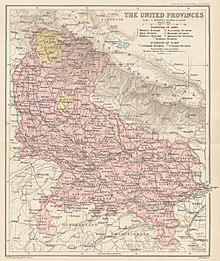
Chaudhary Charan Singh was an Indian politician and a freedom fighter who served as the 5th Prime Minister of India from 1979 to 1980 and the 3rd Deputy Prime Minister of India from January 1979 to July 1979. He served as 5th Chief Minister of Uttar Pradesh as a member of Bhartiya Kranti Dal. Charan Singh is known for his land and agricultural reform initiatives. He is widely regarded as the "Champion of farmers" after his life has been dedicated to advocating for the wellbeing and rights of farmers. He is the first leader outside the Indian National Congress who formed government in the northern India and became 5th chief minister of Uttar Pradesh.

India is a federal republic comprising 28 states and 8 union territories. The states and union territories are further subdivided into districts and smaller administrative divisions.

The Central Provinces and Berar was a province of British India and later the Dominion of India which existed from 1903 to 1950. It was formed by the merger of the Central Provinces with the province of Berar, which was territory leased by the British from the Hyderabad State. Through an agreement signed on 5 November 1902, 6th Nizam Mahbub Ali Khan, Asaf Jah VI leased Berar permanently to the British for an annual payment of 25 lakhs rupees. Lord Curzon decided to merge Berar with the Central Provinces, and this was proclaimed on 17 September 1903.

The Uttarakhand Kranti Dal, is a registered unrecognised regional political party in Uttarakhand, India. Founded in 1979, the party was built upon the aim of establishing a separate hill-state to combat administrative neglect and ensure sustainable development with respect to the sensitive ecology of the Himalayan region. Through the 80s and late 90s UKD became the principal leader of the Uttarakhand Statehood Movement and is credited by for bringing about the separation and creation of Uttarakhand as the 27th state of India on 9 November 2000.

Govind Ballabh Pant was an Indian freedom fighter and the first chief minister of Uttar Pradesh. Alongside Mahatma Gandhi, Jawaharlal Nehru and Vallabh Bhai Patel, Pant was a key figure in the movement for India's Independence and later a pivotal figure in the Indian Government. He was one of the foremost political leaders of Uttar Pradesh and a key player in the successful movement to establish Hindi as the official language of Indian Union.

The Government of India Act 1935 was an Act passed by the British Parliament that originally received royal assent in August 1935. It was the longest Act that the British Parliament ever enacted until the Greater London Authority Act 1999 surpassed it. Because of its length, the Act was retroactively split by the Government of India Act, 1935 into two separate Acts:

Nainital district is a district in Kumaon division which is a part of Uttarakhand state in India. The headquarters is at Nainital.

Rafi Ahmed Kidwai was a politician, an Indian independence activist and a socialist. Kidwai served as a Minister of Communications in the first Cabinet of Independent India. He hailed from Barabanki District of Uttar Pradesh, in north India.

Hemwati Nandan Bahuguna was an Indian National Congress leader and former Chief Minister of Uttar Pradesh; he later joined Bharatiya Lok Dal and worked with Charan Singh.

The Uttar Pradesh Legislative Council also known as Uttar Pradesh Vidhan Parishad is the upper house of the bicameral legislature of Uttar Pradesh, a state in India. Uttar Pradesh is one of the six states in India, where the state legislature is bicameral, comprising two houses: the Vidhan Sabha and the Vidhan Parishad. The Vidhan Parishad is a permanent house, consisting of 100 members.

The Uttar Pradesh Legislative Assembly, also known as Uttar Pradesh Vidhan Sabha, is the lower house of the bicameral legislature of Uttar Pradesh. There are 403 seats in the house. Members of the Assembly are elected by an adult universal suffrage and a first-past-the-post system to represent their respective constituencies, and they hold their seats for five years or until the body is dissolved by the Governor on the advice of the council of ministers. The house meets in the Vidhan Sabha Chambers of the Vidhan Bhavan, Lucknow.
Sir Harry Graham Haig KCSI CIE JP ICS was a British administrator in India.

Bihar Province was a province of British India, created in 1936 by the partition of the Bihar and Orissa Province.

Orissa Province was a province of British India created in April 1936 by the partitioning of the Bihar and Orissa Province and adding parts of Madras Presidency and Central Provinces. Its territory corresponds with the modern-day State of Odisha.

Assam Province was a province of British India, created in 1912 by the partition of the Eastern Bengal and Assam Province. Its capital was in Shillong.
The Uttarakhand movement refers to the events of statehood activism within the undivided state of Uttar Pradesh which ultimately resulted in the formation of Uttarakhand, India as a separate state.

Located in Lucknow, the Vidhan Bhavan is the seat of the bicameral legislature of the Indian state of Uttar Pradesh. The lower house is the Vidhan Sabha and the upper house is called the Vidhan Parishad or the. The Vidhan Sabha had 431 members until 1967, but now comprises 403 directly elected members and one nominated member from the Anglo-Indian community. The Vidhan Parishad has 100 members.
These are lists of Indian governors, both before and after Indian independence in 1947.

The Legislative Assembly for the United Provinces was constituted for the first time on 1 April 1937 in accordance with the Government of India Act, 1935 with a strength of 228. The size of the Uttar Pradesh Legislative Assembly was decided as 403 members after the Uttar Pradesh Reorganisation Act, 2000. There is one nominated Anglo-Indian member in addition to 403 members. The first session of the provisional Uttar Pradesh Legislature under the new Constitution of India that established the country as a republic began on 2 February 1950. After the first elections the newly elected Assembly of Uttar Pradesh met on 19 May 1952.













